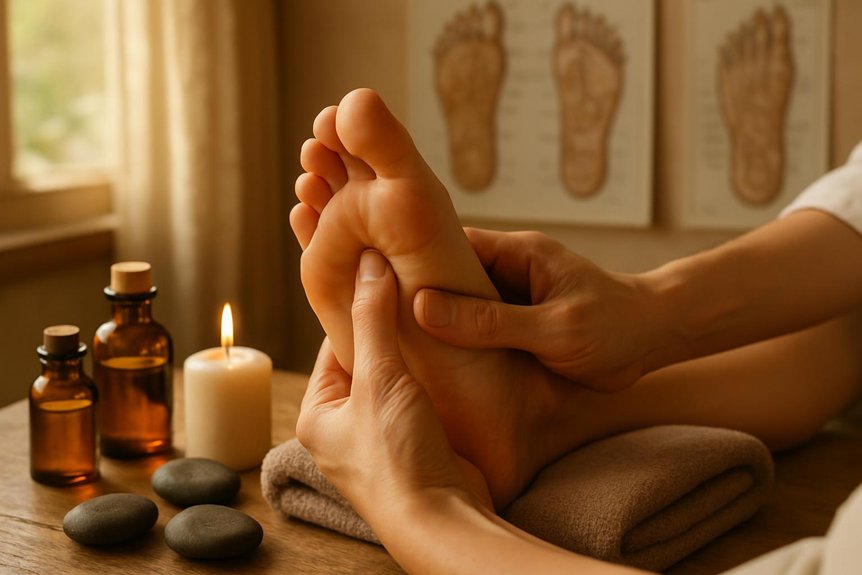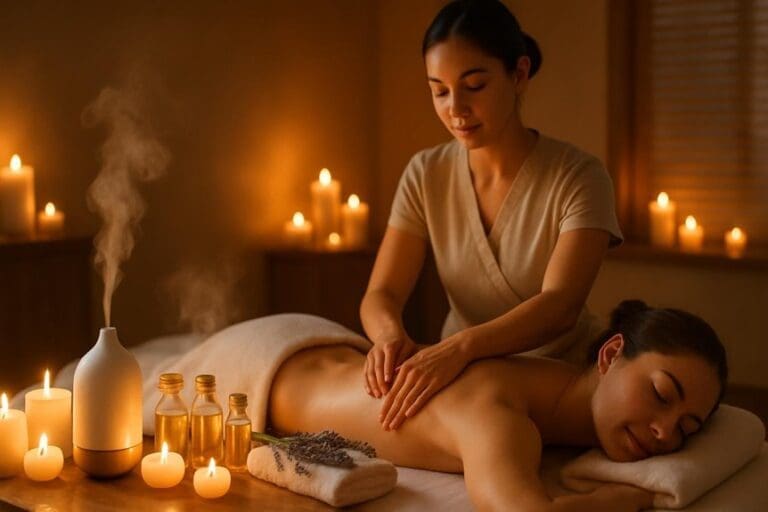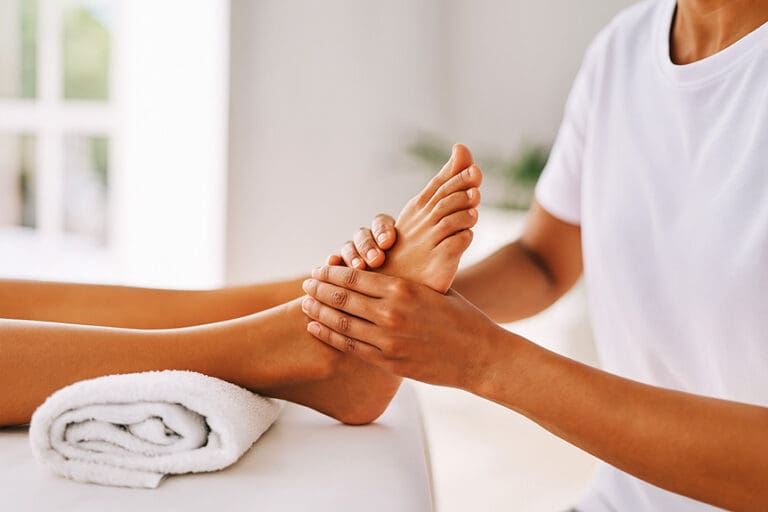Foot reflex therapy is based on anatomical reflex zones mapped on the feet, each linked to specific organ systems. Practitioners apply targeted pressure to these zones, aiming to stimulate neural pathways and support physiological balance. Scientific studies suggest zone therapy may promote relaxation and stress reduction, though direct correlations with internal organs remain debated. While evidence is emerging, it is recognized as a complementary technique in holistic care. Further information clarifies the methodology, scientific basis, and reported client benefits.
Understanding the Principles of Foot Massage

Foot massage is a therapeutic modality grounded in the concept that specific points on the feet correspond anatomically to organs and systems throughout the body. This approach is based on the mapping of reflex zones, where pressure applied to particular areas of the plantar, dorsal, medial, and lateral aspects of the foot is believed to elicit a physiological response in related internal structures.
Proponents suggest that stimulation of these reflex zones may modulate neural pathways, enhance circulation, and support homeostasis. Anatomically, the practice draws on the dense innervation of the feet, which contain thousands of nerve endings.
While evidence is mixed, some studies indicate possible benefits for perceived stress reduction and overall wellbeing. The principles of this therapy emphasize a holistic connection, fostering awareness and intimate self-care. Many practitioners and individuals have reported experiencing the healing power of reflexology, noting improvements in relaxation and overall health.
How this Massage Is Practiced at Spa & Massage
At Spa & Massage, this massage technique is administered by therapists trained in the precise localization of reflex zones, following established anatomical maps of the plantar, dorsal, medial, and lateral surfaces of the foot.
The treatment begins with a detailed assessment of the client’s needs and a gentle cleansing of the feet. Therapists apply focused pressure using thumbs and fingers to specific reflex points, corresponding to organ systems and musculoskeletal structures.
The technique involves systematic palpation, compression, and circular motions, designed to stimulate neural pathways and promote physiological balance.
Each session is tailored to the individual’s comfort level, with attention to tissue response and client feedback.
This methodical approach fosters a calming, intimate environment, supporting relaxation and a sense of connection between practitioner and recipient.
The Science Behind this Massage: What Does Research Say?
Although this massage has been practiced for centuries, the scientific evaluation of its mechanisms and efficacy remains an ongoing area of investigation. Current research explores whether stimulating specific zones on the plantar surface of the feet can influence corresponding organ systems via neural pathways or modulate autonomic nervous system activity.
Some studies report modest reductions in perceived stress and alterations in physiological markers, such as heart rate and blood pressure, though findings are frequently mixed and methodologies vary.
From an anatomical perspective, the direct connection between pressure points on the feet and distant organs has yet to be conclusively established.
At Spa & Massage, therapists integrate evidence-based practices, ensuring each session is grounded in client safety and comfort, while remaining attentive to developments in massage research and technique refinement.
Common Benefits Reported by Clients
Clients undergoing foot massage at Spa & Massage frequently report perceived improvements in peripheral circulation, reduced physiological markers of stress, and enhanced sleep quality.
These outcomes are commonly attributed to targeted manual stimulation of plantar reflex zones, which may influence autonomic nervous system balance.
Such observations align with clinical reports suggesting this massage can contribute to overall somatic relaxation and homeostatic regulation.
Improved Circulation Experience
Many individuals report enhanced peripheral blood flow following foot massage sessions. Clinically, this perceived benefit may relate to the stimulation of cutaneous mechanoreceptors and vascular smooth muscle through targeted manual pressure.
When skilled therapists at Spa & Massage apply systematic techniques to the plantar surface, the manipulation of soft tissue can facilitate vasodilation in superficial and deeper vessels. This process may support improved oxygen and nutrient delivery to distal tissues, especially in the feet and lower limbs.
Clients frequently describe a sensation of warmth and tingling, which could indicate increased microcirculatory activity. While the precise mechanisms remain the subject of ongoing research, Spa & Massage therapists observe that regular session clients often experience improved skin tone and reduced lower extremity fatigue, aligning with these circulatory effects.
Stress Relief Effects
Beyond the influence on peripheral circulation, foot massage is frequently associated with notable stress reduction effects. Evidence suggests that targeted manipulation of plantar reflex zones may activate the parasympathetic nervous system, promoting a measurable decrease in heart rate and cortisol levels.
Clients at Spa & Massage often report a profound sense of calm and diminished muscular tension following sessions, aligning with clinical findings on zone therapy’s anxiolytic potential. By applying gentle, sustained pressure to specific foot regions, therapists facilitate neural feedback loops that modulate hypothalamic-pituitary-adrenal (HPA) axis activity.
This somatic intervention appears to shift autonomic balance toward relaxation. Many individuals describe experiencing warmth, grounding, and a heightened state of bodily awareness, reinforcing the connection between tactile stimulation and psychological equilibrium during massage treatments.
Enhanced Sleep Quality
While research into the mechanisms is ongoing, clinical observations indicate that foot massage may contribute to improved sleep quality by modulating autonomic nervous system activity. Stimulation of specific reflex points, particularly those believed to correspond with the hypothalamus and pineal gland, may help regulate circadian rhythms and facilitate relaxation.
In practice at Spa & Massage, clients frequently report reductions in sleep latency and an increased sense of restfulness following zone therapy sessions. This outcome is potentially linked to decreased sympathetic arousal and enhanced parasympathetic tone, which can promote a deeper state of physiological calm.
Our therapists carefully apply pressure techniques to optimize this response, tailoring each session to individual needs. Many clients adopt this kind of therapy as part of their ongoing routine to support restful, restorative sleep.
What to Expect During a Session
A typical session at Spa & Massage begins with a brief consultation to assess the client’s medical history, lifestyle factors, and specific concerns. Following this, the client reclines in a comfortable position, while the practitioner examines the feet for skin integrity, temperature, and structural abnormalities.
The therapist applies gentle pressure to precise reflex points, corresponding anatomically to organs and systems via somatotopic mapping. Techniques such as thumb-walking and finger rotations are employed to stimulate neural pathways and promote circulation.
Subtle palpation allows the therapist to detect areas of tension or imbalance. Throughout, communication is maintained to ensure the client’s comfort.
Sessions conclude with recommendations for hydration and aftercare, supporting the body’s natural homeostatic processes and optimizing the therapeutic effects of this massage.
How It Fits Into a Holistic Wellness Routine
Integrating this technique within a holistic wellness routine leverages the interconnectedness of the nervous, circulatory, and endocrine systems to support physiological equilibrium. This massage aims to stimulate specific neural pathways through targeted pressure points on the feet, which correspond anatomically to different organ systems.
This stimulation may enhance parasympathetic nervous system activity, promoting relaxation and facilitating homeostatic balance. In clinical practice at Spa & Massage, this is often recommended as a complement to modalities such as therapeutic massage, encouraging integrative care for the body and mind.
Tips for Maximising the Effects of Your Treatment
To optimise therapeutic outcomes from foot massage, several evidence-based strategies can be considered.
Adequate hydration supports metabolic processes and facilitates removal of cellular waste.
Post-session rest allows the autonomic nervous system to recalibrate.
Regularly scheduled treatments at Spa & Massage may enhance neuromuscular adaptation and promote cumulative physiological benefits.
Hydration Before and After
Why does hydration play a critical role in preparing for and recovering from foot massage?
From a clinical perspective, adequate hydration facilitates ideal blood plasma volume and tissue perfusion, which may enhance the removal of metabolic byproducts potentially mobilized during session.
The lymphatic system, responsible for transporting waste and immune cells, also relies on sufficient fluid intake to function efficiently.
At Spa & Massage, therapists recommend clients consume water before and after a session to support homeostatic balance and cellular recovery.
Hydration may reduce the incidence of post-session headaches or mild discomfort, frequently attributed to transient metabolic changes.
This simple but essential step assists the body’s physiological processes, allowing clients to experience the full restorative potential of their treatment in a welcoming, expert-guided environment.
Mindful Post-Treatment Rest
Following ideal hydration, mindful rest immediately after a foot massage session is recommended to support neurophysiological recalibration and autonomic balance.
Clinical evidence suggests that post-treatment rest facilitates parasympathetic nervous system dominance, enhancing vagal tone and promoting systemic homeostasis.
At Spa & Massage, therapists advise clients to remain supine or seated in a tranquil environment for 10–15 minutes post-session. This allows the central and peripheral nervous systems to integrate sensory input from reflex stimulation.
This pause reduces sympathetic arousal, supporting best microcirculation and tissue oxygenation throughout the lower extremities.
Gentle diaphragmatic breathing during this rest period further augments relaxation response, reinforcing the session’s therapeutic effects.
Intimate attention to bodily sensations during this time fosters heightened interoceptive awareness, deepening overall well-being and integration of treatment benefits.
Consistent Massage Sessions
Regularity in zone therapy application is central to amplifying both the immediate and cumulative physiological benefits of treatment. Consistent stimulation of plantar reflex points can encourage *ideal* autonomic nervous system balance and sustained microcirculatory improvements.
At Spa & Massage, therapists often recommend clients establish a tailored schedule—commonly weekly or biweekly—based on individual presentation and therapeutic goals. Repetition allows for adaptive changes in peripheral nerve endings and promotes prolonged relaxation responses, which may support improved sleep, reduced tension, and enhanced subjective well-being.
Anatomically, repeated sessions facilitate the body’s neuromuscular memory, reinforcing positive feedback loops between foot reflex zones and corresponding organ systems.
Clients seeking intimacy in self-care often find that regular appointments foster a deeper sense of connectedness and trust—both with their own bodies and their chosen therapist.
Conclusion
In conclusion, while the anatomical and physiological underpinnings of foot massage remain under scientific scrutiny, its enduring popularity is a proof to its perceived benefits—much like a compass guiding some toward relaxation and homeostasis. Evidence suggests that this therapy may modulate stress responses and promote subjective wellbeing, though robust empirical validation is still evolving. Clients at Spa & Massage can expect a structured, professional approach that prioritises client comfort, anatomical precision, and integration within a broader, holistic wellness regimen.



